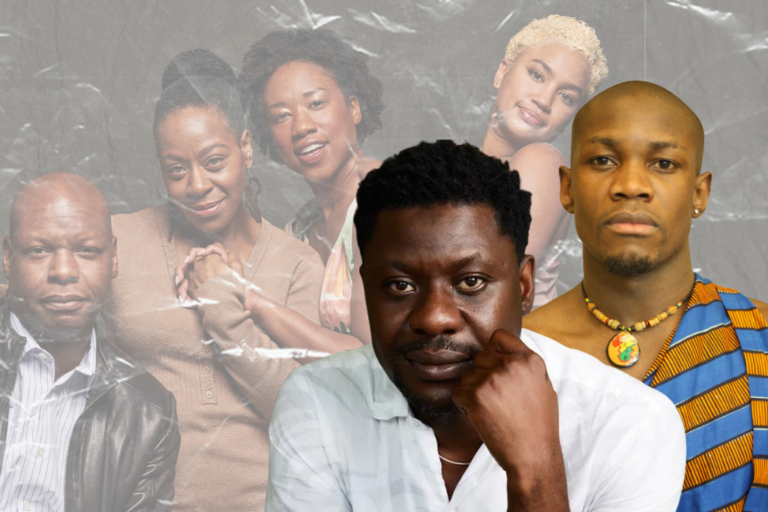Zoom lags, Cyborgs, and Brain-devouring Caterpillars
How is The Drama evolving?
For those of us who spend most of our waking hours on it—or, perhaps, in it—the psychological horror of Zoom is all too familiar. Karen Hines’ The River of Forgetfulness (or Get Me the Fuck Out of this Zoom Play) plays up this horror as it reflects on Zoom as an artistic medium. Filtered through Hines’ signature absurdly disconcerting-yet-captivating style, River… echoes with questions that theatre artists across the world have been asking as they probe the creative possibilities of Zoom: “How is The Drama evolving? What has been the effect of the 44-minute Netflix hour? The 22-minute comedy? What happens during the missing minutes? And what will be the effect of the 1.2 second zoom lag?”
These questions take a dark turn in the play when it’s revealed that hiding in the crevices of the 1.2 second lag between Zoom transmission and reception are humans’ alien doppelgangers, armed with space caterpillars hungry for human brains. The anxieties about Zoom that Hines so deftly captures through this bizarre figuration may resonate with many, but perhaps especially theatremakers, for whom Zoom’s lag may threaten their art’s precious liveness.
We Are All Zoom Aliens
Hines’ play recently finished its run as part of The Stream You Step In, a co-production between Outside the March and the University of Windsor. Also featuring new works commissioned from Elena Eli Belyea, David Yee, and Marcus Youssef, this series was conceived and developed for Zoom, and its plays are arguably impossible to stage in their current form outside of the platform—so much so that they stage a kind of cyborg performance. That is to say: the technologies of Zoom – its mics and cameras – serve as extensions of the actors’ bodies, and can in fact shape their performances. While this is to some extent true of many theatrical forms (for example, musical theatre’s use of mics), on Zoom the integration of actor and technology is total and inescapable. For example, in another one of the plays, Belyea’s The Jubilant, larger-than-life YouTube star Thistle (Bethany Joy Radford) manipulates their appearance through digital filters, morphing into a hamburger as they address the audience about their recent foray into veganism. Thistle determines their next move by soliciting votes from Zoom’s polling feature, crowd-sourcing their decision to go skateboarding over dipping anal beads into Starbucks coffee.
In the Zoom play, technology and actor merge, creating one cyborg creature. In the case of the Zoom lag, the disparity between performance and delivery begs the question: how much of a Zoom performer’s art is dependent upon their access to quality technology and stable Internet connection? When a performer lives within the frame of a camera, does that camera then become a part of them?
Like the humanoid (or even Zoomanoid) cyborg, Hines’ Zoom aliens tap into fears about our over-dependence on technology and its capacity to shape, or irrevocably change, the human body. In her play, four theatre students whose shows have been cancelled due to the pandemic are beset by the brain-devouring caterpillars sent by their Zoom-created alien doppelgangers (who might be read as the duplicate versions of ourselves we see on the Zoom screen). The aliens’ first victim Caleb (played by Caleb Pauzé), goes to his classmates’ house when his internet is disrupted to “suck [their] internet from the outside…with his actor-body.” Like many of us for whom Zoom has become an inescapable daily necessity, Caleb’s selfhood – his very survival – is dependent upon a reliable connection. He becomes a parasite, banned from his friends’ bubble but desperately clinging to the outside for sustenance. At the end of the play, the students’ brains have been entirely devoured, stealing their memories of the theatre they once made. Their language, once their most valuable tool as actors, degrades into gibberish as they “join their minds together” over Zoom.
Tackling the lag
Despite myriad concerns about Zoom, the fusing of the performer’s body with the infrastructure of technology has allowed artists to create work even when performance venues are closed and physical gatherings impossible. The easy access to Internet streaming means that viewers can experience cutting-edge live performance in their living rooms. In order to facilitate this work, technicians, performers, and stage managers collaborate in new ways to overcome Zoom’s many technical challenges. The means through which the four Stream You Step In production teams achieved their complex effects were, in some cases, not even invented when the shows were conceived, but seized upon by designers and technicians later in the creative process as Zoom rolled out updates which could realize the scripted effects (such as the on-screen coexistence of the student actors and their alien doppelgangers at one key moment in The River of Forgetfulness).
To mitigate the unreliabilities of a live streamed show an entire system of contingencies has to be created—over 700 feet of ethernet cable, to start. Dave Gauthier, technical and production coordinator for The Stream You Step In, built a ‘command centre’ in his home which could also run entirely off battery power in the unlikely case of a power outage. A duplicate version of this setup also existed at technician Justin Yelle’s house as an extra precaution. Both also had recordings of the performances ready to go in the worst case scenario – that one or more of the performers lost power in their home and suddenly disappeared from the screen. Gauthier and other technicians worked closely with performers, who shared key tasks like navigating through social media screen shares, setting up lights, and even serving as their own camera crews. Dustin Sedore, Chad in Yee’s good white men, for example, ran part of the show through a screen share from his computer, which required Sedore to play the dual role of performer and technician.

The seemingly simple opening to good white men in which the character Kyle (Gareth Finnigan) livestreams to his Instagram followers posed multiple challenges. First was the twenty-second lag built into the Instagram Live platform. In order for the audience to experience the stream as live, Finnigan had to start it 20 seconds in advance of when the camera would cut to him—a tricky bit of timing choreographed by stage manager Maggie Pinsonneualt calling the show over Discord. Scenic-turned-graphic designer David Court built a digital overlay using text provided by Yee to replicate the flurry of comment bubbles, thumbs, and hearts that float up the page in response to Kyle’s live streamed monologue. For the execution of this effect, the show was dependent on Instagram’s external server by which an outage might have had serious consequences at that evening’s performance.
This inventive use of multiple platforms in good white men, including Instagram live, Twitch, and Facebook, ran up against Zoom’s notorious lag, which despite remarkable feats of technological manipulation could not be entirely eliminated. On a particularly bad night, when Dan Stanikowski’s Dylan delivered an impassioned monologue about performative allyship leading up to the play’s climax, his words trailed behind his mouth movements as much as five seconds later. There’s a certain kind of frustration in knowing that after endless rehearsal and careful technical planning and ingenuity, the ultimate effect of the show might be at the mercy of the quality of its audience members’ internet connections.
The light at the end of the Zoom call
Despite the technical challenges Zoom theatre poses and the anxieties that it provokes, the post-show interviews our research team is conducting with audience members offer glimpses of The Stream You Step In’s success at posing Zoom as a form that is not just a second rate-alternative to live theatre, but a distinct form of theatrical expression that carries its own exciting possibilities.
In Hines’ play the Zoom lag represents a gap in communication, “the crevices between expression and understanding,” and is the source of the show’s creeping horror. And yet even within this most frustrating side-effect of Zoom may lie a spark of hope. As part of the post-show interviews, we ask spectators to recall particular moments of connection they found within the shows. One spectator fixated on an unscripted moment where a performer improvised a line to his co-star in response to the evening’s technical difficulties, “I can’t hear you; there’s a lag.” This moment called to the spectator perhaps because of its intense relatability, not just within the particular circumstances of the performance, but within her experience of life on Zoom in pandemic times. When the performer acknowledged the lag, this spectator experienced an indelible moment of connection—not despite the digital divide, but rather because of it.
This is the second in a series of articles about the creative process of The Stream You Step In. The second part of The Stream, featuring plays by Elena Eli Belyea and Marcus Youssef, has a free, live encore performance on Intermission Ticket, November 25 at 8pm.
Click here for more information.












Comments